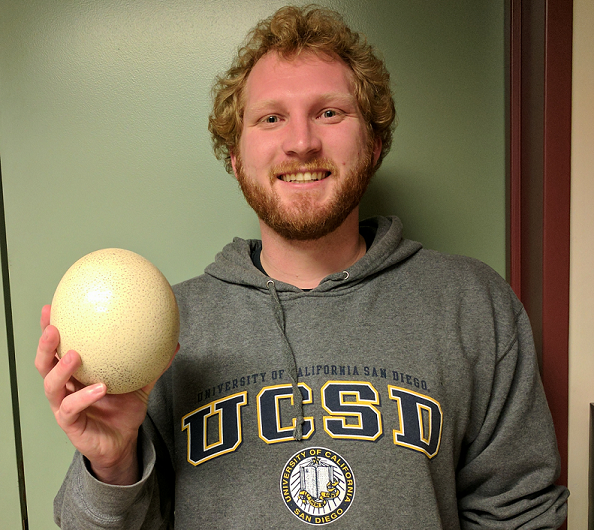How strong is an egg?

Why does holding an egg between two hands and pressing along its long axis make it almost impossible to break? Professor Marc Andre Meyers was first puzzled by this as a child growing up in Brazil. He subsequently proposed the problem to his students which resulted in the paper 'Nature's technical ceramic: the avian eggshell' published today in Journal of the Royal Society Interface.
The function of the eggshell is to protect the embryo from the environment, but it cannot be too strong otherwise the chick would not be able to break out and hatch. It is made of calcium carbonate, an important biomineral, which is different from hydroxyapatite, the mineral component of bone.
In the study, eggs of different sizes, from quail to ostrich, were tested on their strength using an electromechanical system that compressed the eggs between two pieces of rubber. When an egg is compressed in this way, tensile stresses develop radially in the shell. It is only when this radial tensile stress reaches a critical level, equal to the tensile strength of calcium carbonate, that the egg breaks.
Chicken eggs were found to have a compressive strength of 100 lbs, whereas ostrich eggs gave values of more than 1000 lbs. Size and shell thickness were the most important factors in determining shell strength. The strength of eggshells decreases with increasing size and thus thickness, but the force required to break the egg increases because the stress (force/area) is less.
Professor Meyers was glad to finally have an answer to the question that's been puzzling him for years:
"We answered the paradox that was posed to me fifty years ago, and that makes me very happy. This paper revealed, for the first time, the mechanism by which the eggs break when subjected to axial compression. It is not the compression by my hands that breaks the egg, but the tension generated radially."
Speaking about expanding the work, he said:
"We would like to check the universality of our equations by testing eggs of all kinds of birds. There are a variety of interesting birds that we did not test because their eggs are difficult to come by: penguins, eagles, dinosaur…"
In 2015 the number of table eggs produced in America was 83.1 billion. Of these, roughly 6.4% are expected to be damaged or broken between production and reaching the consumer. And with a dozen eggs averaging $2.47 this equates to a loss of over a billion dollars annually in the US alone.
Understanding the biomechanics of eggshells has never been so important.
More information: Eric N. Hahn et al. Nature's technical ceramic: the avian eggshell, Journal of The Royal Society Interface (2017). DOI: 10.1098/rsif.2016.0804
Journal information: Journal of the Royal Society Interface
Provided by The Royal Society



















